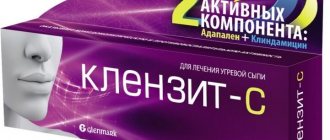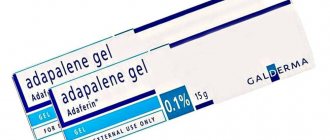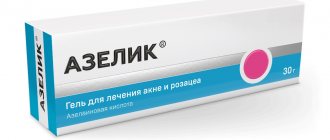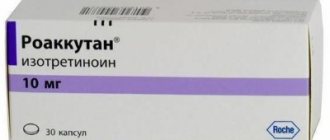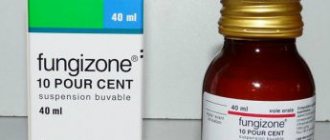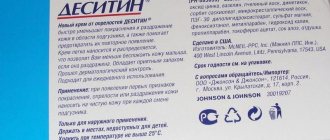For the treatment of dermatological diseases, pharmacological preparations for topical use in the form of solutions or ointments are often prescribed; products based on zinc and its compounds are particularly effective.
One of these drugs is Tsindol, which is included in complex therapy for the treatment of various skin rashes.
The product must be used in strict accordance with the instructions supplied with it; the basic rules and features of its use are given in the proposed article.
Composition and release form
The only form of release of the drug Tsindol is a solution intended for external use. Sometimes there is information about Tsindol ointment, which is a common mistake that arose due to confusion with zinc ointments.
However, such a remedy is sometimes prepared at home; to do this, it is enough to let the bottle with the solution sit until a thick sediment forms at the bottom of the container. Its consistency allows for local use as an ointment that retains the basic properties of the drug, which is why the solution is also called mash.
The main active ingredient of Tsindol is zinc oxide; its content in 100 ml of solution is 12.5 g.
The composition also contains the following components:
- 70% ethyl alcohol - has a drying effect;
- Distilled water is a substance that nourishes the skin;
- Medical talc - has excellent adsorbing properties, removes excess moisture;
- Starch - saturates the skin with useful substances and vitamins, improves its tone;
- Glycerin - helps regulate skin moisture.
Zinc oxide has healing and antiseptic properties, due to the denaturation of protein in the substance, and is also the best UVA reflector and a key ingredient in sunscreen lotions, creams for
diapers, baby powders and acne creams.
Tsindol is sold in pharmacies, the main type of packaging is opaque glass bottles of 100 or 125 ml.
What is Tsindol
The drug Tsindol is classified as a dermatotropic. Sold in a dark glass bottle of 125 ml in a cardboard box with attached instructions. It is a colorless suspension with slight sediment for external use.
The active component of Tsindol is zinc oxide. It has antiseptic and anti-inflammatory properties. Dries and forms a protective barrier on the surface of the epidermis.
Excipients are:
- Ethyl alcohol – effectively copes with skin impurities, disinfects and disinfects.
- Glycerin – helps maintain water balance, nourishes and moisturizes.
- Starch.
- Talc is a medical product that removes excess sebum and reduces the formation of pustular processes.
- Distilled water.
Shelf life is up to 2 years in a cool and dark place, away from children.
Indications for use
The use of Tsindol solution is necessary if the patient has the following indications:
- Local inflammatory lesions of the skin arising from systematic exposure to moisture or mechanical friction;
- Skin irritations caused by increased sweating;
- Necrosis of soft tissues caused by systematic pressure;
- Dermatitis such as contact, diaper and allergic;
- Various forms of ulcerative skin lesions and violation of the integrity of the upper layers of the epidermis;
- Thermal burns of the first and second degree;
- Dermatological diseases caused by streptococcus;
- Herpes and chickenpox;
- Eczema at the acute stage, the only exception is the purulent form of the disease;
- Excessive acne and subcutaneous pimples.
Composition of the chatterbox
To understand whether Tsindol helps with acne, you need to study its components. The drug has the following components:
- Zinc oxide is a virgin substance aimed at drying out existing rashes, regulating the activity of the sebaceous glands, fighting inflammatory processes, and disinfecting the skin.
- Talc is a medical product that eliminates excess epithelial fat and can eliminate pustules.
- Glycerin – destroys pathogenic microorganisms, prevents excessive drying of the integument.
- Starch - soothes irritated areas, nourishes the dermis with vitamins B, C, PP, as well as calcium, iron and potassium.
- Ethyl alcohol – cleanses dirt well, reduces fat content, and disinfects.
In addition to the listed beneficial properties of the main components of the suspension, Tsindol against acne on the face has protective functions. It forms a special layer on the skin that prevents acne pathogens from re-entering.
Useful properties and effect of the drug
The use of Tsindol solution allows you to achieve the following positive results:
- Drying wounds and wet lesions on the skin , leading to accelerated regeneration of damaged tissues;
- Antiseptic treatment , due to which pathogenic microflora is removed and protection is provided against the addition of secondary infections;
- Suppression of acute inflammatory processes occurring in areas of skin lesions;
- Compaction of the upper layers of the epidermis , leading to a decrease in their permeability.
Such dermatotropic properties of Tsindol are due to the presence of zinc oxide in the solution, which makes it possible to effectively combat pathological processes occurring in different layers of the epidermis.
All positive results are achieved due to the following effects of the drug:
- Ensuring the synthesis of albumin salts and changing other protein compounds at the molecular level;
- Reduced activity of enzymes responsible for the development of inflammatory processes;
- Reducing the volume of fluid secreted in areas of inflammation;
- Creation of a protective antibacterial layer consisting of denatured proteins;
- Softening irritated skin areas.
pharmachologic effect
The medicinal substance has a pronounced antiseptic effect. This is a universal remedy in the fight against non-infectious and other dermatological diseases.
Thanks to its safe composition, it can be used by a wide range of people with different skin types. The active substance of the drug specifically acts to relieve the inflammatory process, providing an astringent, drying, adsorbent and decongestant effect.
In general, Tsindol has a positive effect on the skin and suppresses the active course of the pathological process. When applied to the skin, it forms salts, leading to denaturation of protein structures. The latter is extremely important for the treatment of rashes, pimples, burns and other formations, since film formation occurs. It has a protective function against the harmful effects of adverse factors.
How to use it correctly?
Basic rules for the use of Tsindol, which must be followed for any indications and purposes:
- The solution can only be used for external use;
- It is necessary to avoid its contact with mucous membranes and the gastrointestinal tract;
- To increase safety, it is recommended to use personal protective equipment, including disposable medical gloves.
Preparation for use of Tsindol
Preparation for use of the solution is carried out in accordance with the following instructions:
- Only dry and clean skin is allowed to be treated , so the affected areas are washed with warm water before the procedure - this must be done carefully so as not to cause even more damage;
- The washed area of skin is blotted with cotton napkins or a towel , but friction and other methods of mechanical impact must be avoided;
- The affected area of skin must be kept in the open air for 10-15 minutes to completely dry the surface of the skin;
- Tsindol solution has a tendency to precipitate , so the bottle with the drug should be shaken before use to ensure a uniform and uniform structure.
General rules for use for skin lesions
The standard regimen for using Tsindol is used in the treatment of most dermatological diseases, during which pharmacological preparations based on zinc are prescribed.
Consists of the following features:
- The volume of solution used is determined individually depending on the area of the lesion : there is no need to use too much of the drug, it is enough to cover the affected areas of the skin with a thin, uniform layer;
- If the affected area is small, it is most convenient to apply Tsindol in a targeted manner using a cotton swab. For extensive lesions, sterile swabs or cotton pads are used for these purposes;
- The drug should remain on the skin for 2-4 hours , during this period it is necessary to avoid contact with the treated surface;
- After the specified period has expired, Tsindol is washed off the skin with warm water ; soap and other hygiene products do not need to be used;
- The procedure is repeated 4 to 6 times a day depending on the severity of the lesions;
- The duration of the course is determined individually and depends on the positive dynamics ; treatment is carried out for at least 3-4 days.
If it is necessary to take a course lasting more than a month, it is necessary to coordinate the treatment with a specialist.
Use for severe lesions
For severe and extensive skin lesions, masks based on Tsindol are used.
Application is carried out according to the following scheme:
- The product is applied in layers , using both the solution itself and the sediment, which has a thick structure and is more suitable for such an application;
- Wait 10 minutes and repeat applying the product to the dried layer;
- Apply gauze to the treated areas and moisten the top with cool water;
- After 20 minutes, remove the gauze , but do not rinse off the remaining product;
- If you have oily skin, you don’t have to wash off the drug ; in other cases, remove its remnants 4-5 hours after the procedure;
- At the final stage, it is recommended to carry out additional treatment using an alcohol solution based on salicylic acid and cosmetic products for skin care with a moisturizing and nourishing effect;
- Between applying masks with Tsindol, it is necessary to maintain a break of 4 days ; for dry skin, you can take a break of 5-6 days;
- It is necessary to continue this use of the solution until the damaged area of skin is completely healed . In any case, the duration of the course should not exceed 2 months.
Use for wounds and burns
When treating thermal burns and wounds on the skin surface, the solution is used according to one of the following schemes:
- Treat with a solution and apply a thin layer to the affected area of skin . A gauze bandage is applied on top only if protection from external factors is necessary;
- Wetting a sterile dressing that is applied to deep wounds or extensive burns . The bandage should be worn on an ongoing basis; it is changed after standard hygiene procedures, the solution has dried, or in accordance with the chosen method of treatment.
Use for diaper dermatitis
One of the indications for the use of Tsindol is diaper dermatitis.
His treatment is carried out in accordance with the following instructions:
- Treatment begins immediately after the first signs of diaper dermatitis appear , even with mild irritation;
- The solution is applied locally only to areas of the skin that are affected or have contact with wet underwear;
- Scheduled treatment is carried out 3 times a day , additionally the procedure is carried out when changing wet underwear.
Use for chickenpox and herpes
When treating chickenpox or herpes, Tsindol is used according to the following scheme:
- A cotton swab is moistened in the solution, after which spot treatment of skin rashes is carried out;
- The procedure is repeated 1-2 times a day at equal intervals;
- Tsindol is used only as an adjuvant, it is not intended for the treatment of chickenpox or herpes;
- It is necessary to continue treating the lesions until they are completely cured, but not longer than the maximum permissible period - 1 month.
The use of Tsindol in the treatment of chickenpox is practiced instead of treatment with brilliant green.
Such measures have the following advantages:
- Rapid stimulation of regenerative processes, reducing the risk of scar formation in areas with deep ulceration;
- No noticeable traces of the solution on the skin, while clothes and bedding remain clean;
- No discomfort during treatment.
Use during pregnancy and lactation
During pregnancy or lactation, standard indications for the use of Tsindol may arise.
The substances included in the drug are not absorbed into the blood through the epidermis, even when treating open wounds with the solution.
Therefore, the following rules are established:
- External use of Tsindol is allowed at any stage of pregnancy;
- External use of Tsindol is allowed during lactation without interrupting breastfeeding.
Use for newborns
Tsindol solution is an absolutely safe drug that does not cause adverse reactions even in newborns.
For infants, the drug is prescribed if the following indications exist:
- Allergic skin rashes;
- The appearance of diaper rash;
- Prickly heat;
- Diaper dermatitis;
- Local irritations caused by wearing clothes or diapers.
When treating newborns using Tsindol, you must adhere to the following rules:
- Application to the facial skin of newborns is prohibited , even if there is irritation on it. Failure to comply with this rule leads to drying out of the upper layers of the epidermis and subsequent peeling, which may result in the addition of pathogenic microflora;
- In newborns, application is carried out locally only on the affected areas of the body . The only exceptions are places in contact with wet laundry - they can also be treated for preventive purposes.
- After changing diapers, re-application of the product is always required..
The use of Tsindol for newborns is recommended according to the scheme described in detail below:
- In the morning, water procedures are carried out using a solution of potassium permanganate , which has a faint pink tint;
- After water procedures, pat the child dry with a cotton towel and allow the skin to dry naturally; Apply local application of Tsindol to clean skin; After treatment, do not dress the child, allowing the preparation to dry naturally in the air.
- Repeated applications of the drug are carried out during the day if necessary. Each time, the skin must be cleansed of sweat, urine or other contaminants, after which it is again treated with a solution;
- In the evening, be sure to bathe in a bath with the addition of potassium permanganate or chamomile decoction to get rid of any remaining drug on the skin;
- The duration of use of Tsindol is 2-4 days , this time is usually enough to get rid of the symptoms of allergies, dermatitis, prickly heat and other skin irritations.
Use in childhood
The use of Tsindol without restrictions is allowed in childhood.
The main indications are:
- Insect bites accompanied by itching, swelling and redness;
- Herpes;
- Chicken pox;
- Diathesis;
- Mechanical damage to the skin;
- Allergic rashes;
- Skin rash accompanied by local inflammation;
- Local peeling.
The rules for using Tsindol depend on the indications available; instructions are given below:
- In all cases, only clean surfaces and thoroughly dried areas of skin are allowed to be treated;
- The drug must be washed off 2-3 hours after application, the treated area should be lubricated with baby cream;
- When treating burns, a sterile bandage is applied, which is also moistened with the solution;
- When treating wounds, scratches and other damage to the integrity of the skin, the solution is applied in a thin layer, applying bandages is not required;
- When treating allergic dermatitis, treatment is carried out 2-3 times a day until the irritation is completely eliminated.
Regardless of the indications for use, Tsindol should not be used for more than a month.
How does Tsindol affect acne?
Tsindol is an excellent remedy for the treatment of acne in adolescence and adults. All thanks to the effective and natural composition.
Pimples are formed as a result of dysfunction of the sebaceous glands. And zinc oxide, an active ingredient, helps regulate their work. Dries and disinfects existing rashes. Whitens the skin and removes oily shine. Additional components enhance the therapeutic effect.
The drug can be used for treatment purposes not only in its pure form, but also can be used to prepare ointments, masks and special cleansers at home.
To eliminate acne, the suspension is applied to clean skin at night and washed off with water in the morning. The area of influence of the drug is extensive; it is allowed to treat the back, shoulders, face and décolleté.
For dry skin types, leave the ointment on the surface for no more than 3 hours and wash off with warm water.
Side effects
In most cases, Tsindol does not cause any unwanted reactions.
However, the following side effects are sometimes possible:
- Peeling of the skin usually occurs when it tends to dry out or when the solution is used too long and often;
- Redness, itching and burning sensation, increased skin temperature in the treated areas and other manifestations of physical discomfort indicate an allergy to the drug and require its discontinuation.
If side effects are severe, it is necessary to rinse the treated areas with cool water and contact a specialist so that he can help you choose more suitable preparations without zinc.
The use of the solution in any dose does not cause side effects from the nervous system.
Therefore, when undergoing treatment with the use of a solution, there are no restrictions on driving vehicles and other mechanisms, as well as on carrying out activities that require increased concentration.
Indications and contraindications
Due to its composition, the drug can even be used to treat rashes in newborns. It is safe for most people and rarely causes allergies. That is why Tsindol has gained great popularity as a means to get rid of the symptoms and consequences of diseases such as:
- Dermatitis
. Including atopic. - Chickenpox
. Helps reduce itching, dries out rashes and disinfects. After using the suspension instead of the often used brilliant green, rapid healing of wounds and the absence of scars were noted. - Acne treatment
. It is necessary to smear the inflammation. - Potnichka
. Due to its drying effect, it helps accelerate skin healing. - Diaper rash
. The suspension can be used from the first month of a child’s life, so it will help eliminate skin irritation and inflammation even in the youngest. - Skin ulcers
. Antibacterial and drying effects contribute to the careful and rapid restoration of the skin. - Herpes
. The astringent properties help to form a crust on the surface of the pustules, preventing them from bursting, and the active ingredients cope with inflammation. - Eczema
. Soothes the skin and fights itching. Significantly reduces the inflammatory process. - Burns
. Apply as a compress to the damaged area. - Scratches
. The use of a suspension is especially useful if it was not possible to promptly disinfect the wound. - Insect bites
. Reduces the feeling of itching, heals. - Other inflammatory processes on the skin.
Tsindol can also be used by pregnant women if inflammation associated with hormonal changes occurs. It can also be used for preventive purposes to protect the skin when constantly in a humid environment. If the drug is used for infants and small children, control by both parents and a doctor is required in order to eliminate even the slightest danger to the child.
Do not use Tsindol if a purulent infection occurs!
Tsindol is used to reduce the moisture of weeping wounds, ulcers and other skin damage. This is a simple, affordable and safe tool that is convenient and easy to use. If you follow the instructions for use, side effects are extremely unlikely.
Contraindications for use
If you are allergic to one or more components of the drug, Tsindol is contraindicated. It is not recommended to treat children less than a month old with Tsindol without instructions from a specialist. It is also worth considering the characteristics of the skin: if it is prone to dryness, the suspension can enhance this characteristic.
When using for a long time, you should take breaks to give your skin a rest.
Itching, urticaria or burning is extremely rare. This may indicate individual intolerance. If such symptoms occur, you should stop using the drug and consult a specialist.
Storage conditions and periods
Tsindol must be stored at home in compliance with the following rules:
- Temperature regime not higher than +15°C;
- No exposure to direct sunlight;
- Protection from children and pets;
- Separate storage from dishes and food.
If the described conditions are met, a closed bottle of solution can be stored for 2 years from the date of manufacture.
During long-term storage, sediment may form, which is a normal and natural process: just shake the bottle vigorously to restore the structure of the solution.
The sediment can also be used as a medicine for external treatments.
special instructions
There is no data on the interaction of Tsindol with other drugs.
You can purchase the drug at a pharmacy; it is available without a doctor’s prescription.
It should be stored out of the reach of children at a temperature of 18-25 degrees.
Shelf life – 24 months.
Use during pregnancy and breastfeeding
The drug is effective for prickly heat, skin rashes, itching, redness of the skin, and allergies. During pregnancy, small pimples may appear, which Tsindol can fight.
While carrying a child, the expectant mother's skin may peel off, rashes, redness and other skin irritations may appear. The product can also be used for scratches, abrasions and insect bites.
Possible analogues
Below are drugs that have similar pharmacological effects and can be used as substitutes for Tsindol:
- Calamine is a very close analogue; it contains zinc and iron in the form of oxides. The drug is an antiseptic solution produced in Israel. Synthetic substances are excluded from the composition, which reduces the negative impact on the body. Use is permitted in childhood and during pregnancy. You can purchase a 100 ml bottle for a price starting from 800 rubles ;
- Desitin is an American-made drug based on zinc oxide. The product is especially effective in the treatment of herpes, and is also used to stimulate recovery processes in the presence of cuts and wounds. Release form: ointment for topical use with a characteristic fishy odor. Approved for use in children. The cost of a tube is 250-300 rubles ;
- Diaderm - under this name various products for external use are produced, including an anti-inflammatory drug based on zinc oxide. Treatment can be carried out up to 4-6 times a day, the course duration is 1 month. The average cost of the drug is 60-80 rubles ;
- Galmanin - differs from Tsindol in a lower concentration of zinc oxide, which is compensated by the addition of 2 grams of salicylic acid. The drug is available in powder form for external use and is used to relieve inflammation and dry out weeping irritations. Treatment of children over 12 years of age is allowed. The cost is 30-50 rubles .
Calamine Desitin Diaderm Galmanin
For babies
When used correctly, Tsindol will not cause any harm to the baby. Even in the case of weeping wounds, the drug is not absorbed into the blood; it has only an external effect.
The product is indicated for use in allergic and diaper dermatitis, diaper rash, heat rashes, and irritations.
The most optimal scheme for using the suspension is as follows. In the morning, the child is bathed in a bath with the addition of a small amount of potassium permanganate. No detergents required.
Next, the baby is carefully dried with a soft towel, and the damaged skin is treated with mash. There is no need to dress the baby, because the drug must dry.
Throughout the day, you need to examine the baby’s skin for the presence of Tsindol on it. If necessary, the medicine is reapplied. In the evening, the child is again bathed in water with potassium permanganate, washing off the drug.
This treatment regimen allows you to notice the first positive changes after just a few days. The suspension sometimes causes flaking if used on delicate facial skin. So for children under 1 year of age, it is recommended to use the medicine on the torso, arms and legs.
Instructions for use: masks, compresses, ointment, cleanser
Tsindol works great on pimples, but it is very important to use it correctly. It is applied exclusively to problem areas using a cotton swab, left for 15-20 minutes (until dry), and washed off with water. You can also apply cindol before bed and wash it off only in the morning. This method of application is more effective, but can lead to severe peeling and drying of the skin.
In most cases, cindol helps eliminate pimples in just a few treatments. If there are few acne, 3 sessions will be enough, but if a large surface is affected, up to 10 procedures will be needed.
To get rid of acne and other purulent rashes, it is useful to make mask-compresses with cindol. Apply cindol to clean and dry skin with a cotton pad, wait about 8 minutes, then apply another layer. Place gauze lightly moistened with water over the suspension. Leave the compress for 20 minutes and remove. The product remaining on the skin should not be washed off for about 10 hours. The mask can be done no more than a couple of times a week. The course of treatment is 1-2 months.
Often, cindol is used as a cleanser. It is an excellent preventative against acne, relieves inflammation, and regulates the functioning of the sebaceous glands. As a cleanser, cindol is applied to the entire face, left for 2 minutes and washed off with gel, milk, foam, etc.
